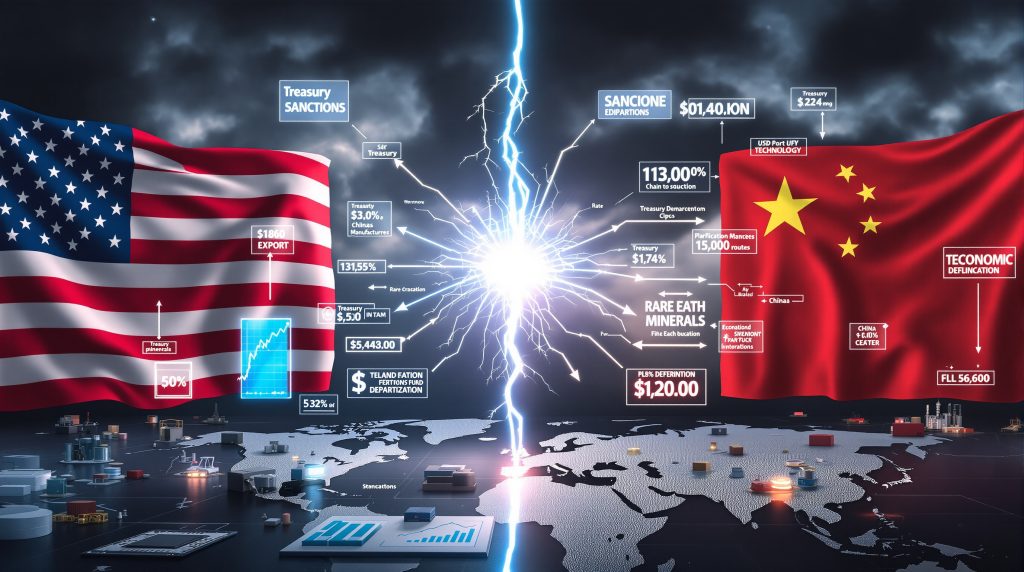How Are Recent US-China Sanctions Reshaping Global Trade?
The United States and China have intensified their economic competition through increasingly sophisticated sanctions and export controls. This represents more than typical trade friction—it's a fundamental strategic rivalry between the world's two largest economies as they maneuver for advantage in ongoing negotiations while preparing for long-term technological and economic competition.
As of 2024, US-China bilateral trade totaled approximately $575 billion, making China one of America's largest trading partners despite ongoing tensions. The U.S. has sanctioned over 1,400 Chinese entities across various lists including the Entity List, Specially Designated Nationals list, and sector-specific sanctions.
According to economic analysts, these escalating measures are fundamentally rooted in geostrategic and military competition, and this pattern will persist even as trade negotiations continue between Washington and Beijing.
The Strategic Context Behind Recent Measures
The rivalry has evolved beyond traditional trade disputes into a multifaceted competition encompassing national security, technological leadership, and global influence. Both countries are strategically positioning themselves for long-term advantage.
The shift from tariff-based approaches (which dominated 2018-2019 trade tensions) to targeted entity sanctions and export controls represents a more surgical approach to economic statecraft. Entity List designations under the Export Administration Regulations prevent U.S. companies from exporting specific technologies without licenses, while Specially Designated Nationals designations freeze assets and prohibit transactions.
This transformation reflects several key developments:
- Deepening geopolitical rivalry beyond traditional trade disputes
- Increasing focus on critical technologies and supply chain security
- Shifting from tariff-based measures to targeted sanctions and export controls
- Growing emphasis on national security justifications for economic actions
What New Sanctions Has the US Imposed on China?
The United States has deployed increasingly sophisticated economic measures against Chinese entities, focusing on strategic priorities that extend beyond typical trade concerns.
Most recently, in October 2025, Washington imposed sanctions on multiple Chinese entities, specifically targeting an independent refinery and terminal allegedly involved in Iranian oil transactions. This approach exemplifies how the U.S. is using "secondary sanctions" to target non-U.S. persons engaging with sanctioned jurisdictions, effectively extending U.S. jurisdiction extraterritorially through dollar-system access restrictions.
Energy and Iran-Related Sanctions
The targeting of Chinese refineries and shipping terminals for Iranian oil transactions reflects Washington's strategy of enforcing sanctions against Iran through pressure on Chinese intermediaries, which has become a recurring pattern in US-China trade war strategies between the economic powers.
- Designation of Chinese refineries and shipping terminals allegedly involved in Iranian oil transactions
- Treasury Department sanctions targeting Chinese firms in Iranian procurement networks
- Restrictions on financial institutions facilitating sanctioned transactions
Technology and National Security Controls
- Expansion of the Entity List to include hundreds of Chinese technology firms
- Implementation of stricter semiconductor export restrictions
- Foreign Direct Product Rule applications preventing third-country sales to China
- Investment restrictions in sensitive sectors like quantum computing and AI
Human Rights-Based Measures
- Targeted sanctions against officials linked to policies in Xinjiang and Hong Kong
- Restrictions on imports from regions with alleged forced labor concerns
- Visa restrictions on Chinese officials deemed responsible for rights abuses
How Has China Retaliated Against US Sanctions?
Beijing has developed a comprehensive counter-sanctions strategy, leveraging its dominance in critical supply chains and expanding its regulatory framework to respond to U.S. measures.
In October 2025, China issued six separate notices outlining expansion of its export control regime. Simultaneously, Beijing added 14 Western entities to its "unreliable entity list," including multiple U.S. firms in the drone industry and a Canada-based entity that published analysis on advanced chips manufactured by Huawei Technologies.
The timing of China's six-notice announcement—hours before the U.S. sanctions announcement—suggests coordinated strategic positioning by both sides as they seek leverage in ongoing negotiations.
Strategic Resource Export Controls
China's October 2025 export controls specifically targeted:
- New restrictions on rare earth production technologies and equipment
- Export controls on specific rare earth elements critical for defense applications
- Limitations on lithium battery production equipment exports
- Controls on superhard materials with industrial and defense applications
"Unreliable Entity" List Expansion
China's October 2025 unreliable entity list addition targeted a consultancy that conducted "teardown reports" examining Huawei chips, demonstrating Beijing's willingness to sanction research and analysis firms, not just commercial entities.
- Addition of 14 Western companies to China's blacklist
- Targeting of US drone industry firms with market access restrictions
- Sanctions against foreign research entities publishing technical analysis on Chinese technology
- Implementation of compliance requirements for foreign firms operating in China
Maritime and Logistics Countermeasures
- Introduction of special port fees targeting US-owned or operated vessels
- Increased customs scrutiny of US-origin goods
- Enhanced inspection regimes for US-affiliated shipping companies
What Sectors Are Most Affected by the US-China Sanctions Battle?
The economic confrontation between Washington and Beijing has created particular vulnerabilities in several key industries, with ripple effects throughout global supply chains.
Critical Minerals and Rare Earths
China controls approximately 70% of global rare earth mining and 90% of rare earth processing capacity. Global rare earth oxide production reached approximately 350,000 metric tons in 2024, with China accounting for roughly 240,000 metric tons.
China's October 2025 restrictions cover rare earth production technologies and equipment, plus additional rare earth elements beyond those previously controlled. These materials are critical for permanent magnets in electric vehicles and wind turbines, defense applications including precision-guided weapons, and electronics and telecommunications equipment.
The impact of these restrictions includes:
- Disruption to global supply chains for magnets and electronic components
- Price volatility in rare earth markets
- Accelerated efforts to develop alternative raw materials supply outside China
- Strategic stockpiling by both governments and private sector
Semiconductor and Advanced Technology
- Fragmentation of global chip supply chains
- Increased costs for consumer electronics manufacturers
- Acceleration of parallel technology ecosystems
- Challenges for multinational companies navigating dual compliance regimes
Energy Markets
- Realignment of global oil flows as Chinese refiners adjust sourcing
- Price impacts on sanctioned energy products
- Development of alternative payment mechanisms to circumvent dollar-based sanctions
- Growing energy trade between China and sanctioned countries like Iran and Russia
What Are the Global Economic Implications of Escalating Sanctions?
The ripple effects of US-China economic confrontation extend far beyond bilateral trade, reshaping global economic relationships and business strategies in fundamental ways.
According to economic analysts, the fundamental driver of the escalating China US trade sanctions is geostrategic and military rivalry, meaning that despite trade negotiations continuing between Washington and Beijing, the sanctions measures will likely persist as a structural feature of the relationship.
Supply Chain Restructuring
- Acceleration of "friend-shoring" by Western companies
- Chinese push for self-reliance in critical technologies
- Rising production costs as supply chains optimize for security over efficiency
- Emergence of parallel supply chains for sensitive industries
International Trade Governance
- Weakening of WTO dispute resolution mechanisms
- Proliferation of national security exceptions to trade rules
- Growing regionalization of trade agreements and standards
- Increased compliance burdens for multinational corporations
Third-Country Impact
- Strategic positioning by middle powers between US and Chinese economic spheres
- Opportunities for alternative suppliers in sanctioned sectors
- Compliance challenges for countries with strong ties to both powers
- Growing pressure to choose sides in technology standards and governance
How Are Businesses Adapting to the New Sanctions Environment?
Companies caught in the crossfire of US-China economic tensions are developing sophisticated strategies to navigate an increasingly complex regulatory landscape.
The October 2025 additions demonstrate the expanding scope of sanctionable activities, with research and analysis firms now targeted (as seen in the Canada-based entity sanctioned for chip analysis), drone technology companies across multiple firms, and oil shipping and refining intermediaries.
Compliance and Risk Management Strategies
Companies operating in both markets must navigate complex compliance requirements, including:
- U.S. Export Administration Regulations (EAR)
- U.S. Treasury OFAC sanctions programs
- China's Export Control Law (effective December 2020)
- China's Unreliable Entity List mechanism
- China's blocking statute provisions
This complexity has driven businesses to implement:
- Development of sophisticated sanctions screening protocols
- Geographic diversification of supply chains and manufacturing
- Creation of separate China and non-China business units
- Enhanced due diligence for business partners and suppliers
Technology Decoupling Responses
- Parallel product development for different markets
- Localization of data storage and processing
- Careful IP management across jurisdictions
- Strategic decisions about which markets to prioritize
Investment and Expansion Adjustments
- Reassessment of China investment plans by US firms
- Chinese companies' pivot to domestic market and friendly jurisdictions
- Rise in joint ventures to navigate regulatory barriers
- Increased political risk insurance and contingency planning
Will US-China Trade Negotiations Reduce Sanctions Pressure?
Despite the escalating sanctions environment, diplomatic channels remain open as both sides recognize the costs of unrestricted economic conflict.
According to economic analysts, despite the October 2025 round of sanctions measures, the U.S. and China will continue trade negotiations with the aim of reaching a comprehensive bilateral trade agreement.
Current Negotiation Dynamics
The near-simultaneous announcement of sanctions by both sides (China's six notices followed hours later by U.S. sanctions) suggests both countries are attempting to establish stronger negotiating positions rather than abandoning diplomatic channels entirely.
- Ongoing talks despite heightened tensions
- Use of sanctions as bargaining chips for broader agreements
- Selective enforcement and temporary exemptions as diplomatic tools
- Focus on managing competition rather than resolving fundamental differences
Potential Areas for De-escalation
- Targeted tariff reductions in non-strategic sectors
- Establishment of communication channels for sanctions coordination
- Carve-outs for humanitarian and environmental cooperation
- Agreement on basic principles for economic coexistence
Structural Limitations to Compromise
- Fundamental disagreements on technology transfer and industrial policy
- Domestic political pressure against concessions in both countries
- Security concerns overriding economic optimization
- Competing visions for global economic governance
What's Next in the US-China Sanctions Landscape?
The trajectory of US-China economic relations points toward continued strategic competition with carefully managed boundaries.
Under President Donald Trump's administration (as of 2025), U.S.-China trade policy maintains emphasis on strategic competition and technology restrictions. The critical minerals order signed by Trump has accelerated domestic efforts to reduce dependency on Chinese supply chains.
Emerging Battlegrounds
Based on October 2025 actions, emerging control areas include:
- Rare earth production technology (not just elements)
- Lithium battery production equipment
- Advanced semiconductor analysis and research
- Drone technology and components
Additional areas likely to see increased restrictions include:
- Digital currency and financial technology regulations
- Quantum computing and biotechnology restrictions
- Space industry supply chains and collaboration
- Critical infrastructure protection and foreign investment screening
Policy Evolution Trends
- More precise targeting of sanctions to minimize self-harm
- Greater coordination among like-minded countries
- Development of more sophisticated enforcement mechanisms
- Integration of economic and security policy planning
Business Planning Considerations
- Long-term strategic positioning for a bifurcated global economy
- Investment in regulatory intelligence and compliance capabilities
- Scenario planning for further escalation or selective de-escalation
- Balance between access to Chinese market and US regulatory compliance
FAQ: Understanding US-China Trade Sanctions
How do US sanctions against China differ from traditional tariffs?
Sanctions target specific entities, individuals, and activities rather than broadly taxing imports. They often involve prohibitions on transactions, asset freezes, and restrictions on technology transfer, making them more disruptive to targeted sectors but potentially less damaging to overall trade volumes. A detailed tariff impact analysis shows sanctions create more concentrated disruption in strategic sectors.
Can companies operate in both the US and Chinese markets under current sanctions?
Yes, but with increasing difficulty. Companies must navigate complex compliance requirements, potentially separate their operations, and carefully manage technology transfers. Many firms are creating China-specific business units with separate supply chains and technology stacks.
How are rare earth export controls affecting global industries?
China's controls on rare earth production technologies and materials are creating supply uncertainties for industries ranging from electric vehicles to defense. Manufacturers are accelerating efforts to develop alternative sources, recycling capabilities, and material substitutes while building strategic reserves.
What recourse do sanctioned entities have under international law?
Options are limited. While WTO challenges are possible for some measures, national security exceptions often shield sanctions from effective challenge. Affected companies typically must work through their governments for diplomatic solutions or adapt their business models to the new reality.
How do third countries navigate between US and Chinese sanctions regimes?
Many countries are adopting a balancing approach—complying with mandatory US sanctions while maintaining economic ties with China where possible. This often involves careful sector-by-sector analysis, strategic ambiguity, and development of alternative financial channels for permitted trade. Furthermore, the Asian ferroalloys conflict has created particular challenges for regional producers.
Conclusion: The New Normal of Economic Statecraft
The intensifying exchange of China US trade sanctions represents a fundamental shift in the global economic order. What began as a trade dispute has evolved into a comprehensive competition for technological leadership and economic influence, with both powers wielding economic tools for strategic advantage.
This "new normal" of economic statecraft is likely to persist regardless of diplomatic breakthroughs or political changes in either country. The global business community faces a period of prolonged adaptation as supply chains fragment, compliance burdens grow, and strategic sectors become increasingly subject to government intervention.
For policymakers, businesses, and investors alike, success will depend on understanding not just the immediate impacts of specific sanctions, but the broader strategic logic driving both powers toward a more managed economic relationship characterized by selective decoupling, parallel innovation systems, and competing spheres of influence.
Looking to Gain an Edge in ASX Resource Investing?
Stay ahead of the market by receiving instant alerts on significant ASX mineral discoveries through Discovery Alert's proprietary Discovery IQ model, turning complex data into actionable investment insights. Explore Discovery Alert's dedicated discoveries page to see how major mineral discoveries have historically generated exceptional returns for early investors.




